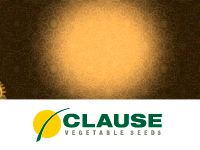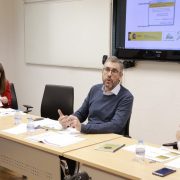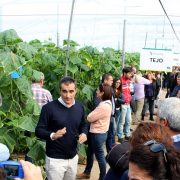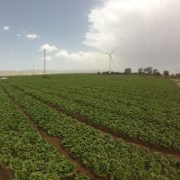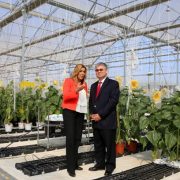Innovation in seeds drives the competitiveness of intensive horticulture
By Pedro Gómez and Carmen García, researchers from the IFAPA Center “La Mojonera”
The horticultural catalog includes thousands of varieties that have been defined as being different, uniform and stable. Every seed breeder knows that these three characteristics make up the DUS test, which is basically the test that gives a new plant variety the denomination of variety and the possibility of being marketed. This great accumulation of differences between the varieties horticultural, differences grouped in characters, make that the horticultural varieties, beyond producing the final food, are the element of production that can provide the widest response to the requirements of the different components of the horticultural production chain. That is, a variety can accumulate several resistances to a virus, essential for the farmer’s production, together with a longer useful life of the harvested fruit, essential for the distributor of the supermarket chain, together with a greater sweetness of the fruit, essential for a group of consumers, etc …
This diversity of characters is accumulated in the cultivars thanks to the Plant Genetic Improvement, and make the plant variety, when innovating in horticulture, the element of greatest plasticity among all the horticultural production system. So much so that in the provinces of Almeria and Murcia, the area with the largest pole of horticultural production in national shelter and one of the main internationally, the largest proportion of research centers are dedicated to the development of new varieties. The majority of seed companies worldwide have research centers in this area. And this work is not only carried out by multinationals, but also with small companies that are born in the areas of production, and public centers that are needed to support this research.
Thanks to this research, the range of products has expanded enormously. Diversification is one of the main objectives of companies that has allowed the production of this field to evolve.
The pepper is a clear example of diversification, since three years ago there were 3 types (California, Italian and Lamuyo) and today there are more than 20 types, including mini that are already served in vending machines in many European countries
In this sense public research has an important role. In the Institute of Agricultural Research and Training and Fishing of the Junta de Andalucía (IFAPA) in its center “La Mojonera”, they have carried out a pioneering project whose main objective is diversification. To do this, together with the comparison of varieties of different crops, marketing formats and channels are analyzed, such as the vending machines for fresh snacks (pepper, tomato, cucumber …) with the ultimate goal of promoting the use of new horticultural products. And in this way, in addition, the farmer can know how to use new crops (ranging from legumes, pumpkin or different crasaceas) or, without abandoning crops that he has done all his life, use very different types that allow him to diversify.
But the innovation in face, and its cost repercute in the final price of the seed. Each year about 200 new varieties of horticultural products are sold in Spain. This high number of new developed products confirms the importance of innovation and the development of new seeds in the horticultural sector, even more if one starts from the data of some 4500 varieties (of 47 crops) that are commercialized annually (ANOVE: Asociación National Plant Breeders).
Only in the province of Almeria there are more than a dozen specialized research centers in the field of vegetables, and it is estimated that more than 2000 new varieties have come out of them
In a framework with such a competitive agriculture, the Genetic Improvement has quickly incorporated the latest genomic analysis technologies to become a more efficient and accurate discipline. Really the Improvement has always been a fundamental pillar of the development of the agriculture along the evolution of the human feeding, that already began from its beginnings with the selection of the agriculturists of more productive crops, of better flavor … But they have been the discoveries of genetics formulated throughout the past century that have generated a new revolution in the development of horticulture. The first qualitative leap in the selection of varieties is due to the application of the studies of the monk Gregor Mendel who discovers in peas the basic mechanisms of the transmission of characters to offspring, and postulates the unit of inheritance: the gene. This is the basis for the planning of the current improvement programs that have led to the great varietal development.
The next big change was the discovery of the nature of the gene, from the Watson and Crick researchers, which allowed the development of a biotechnology for the analysis of the function of genes of interest in agriculture. This biotechnology has evolved, from the sequencing of the human genome, to a new discipline known as Genomics, which allows a view of the genomes as a whole and the identification of which genes control a certain character, be it a resistance or taste of a fruit. For this, the development of technologies for the sequencing of complete genomes is fundamental. At this point, public research organizations in the province of Almeria have actively collaborated in the development of the first complete genomes of very important crops such as tomatoes, in the case of UAL and IFAPA, or zucchini, which was promoted in coordinated projects from the IFAPA. These first sequences have served as a skeleton to identify the genetic diversity of different genomes of these species, and are being applied to the development of new characters. Specific cases are those of coordinated projects from the IFAPA for the selection of new resistances to the ToLCND virus or of greater content in sugars and antioxidants in the fruit, which is carried out in thousands of zucchini lines generated in this institute.
In this constant evolution towards novel techniques, recently a technique has emerged that is once again revolutionizing genomics since it allows for the first time the editing of genes, that is, the change of the sequence in a directed way: CRISPR. Until now, the techniques only allowed to work the genetic variability at random, but with CRISPR this situation has changed since you can change, for example, a single letter of the millions of letters of the genome of a tomato and the result is not a transgenic , it is a variation that could have developed naturally. This can be applied, as the IBMCP researcher Antonio Granell explains, to the à la carte design of something as suggestive as the flavor of the tomato. They have identified (and published in the prestigious journal Science) the genetic code of the 13 chemical compounds responsible for the flavor in this fruit, which are abundant in the ancestral varieties. This new way of designing any character of a crop supposes a very effective approach to the Genetic Improvement that can suppose a new paradigm at the time of developing new varieties.
YOU MIGHT ALSO LIKE:
➡️Biological control in greenhouse horticultural crops






